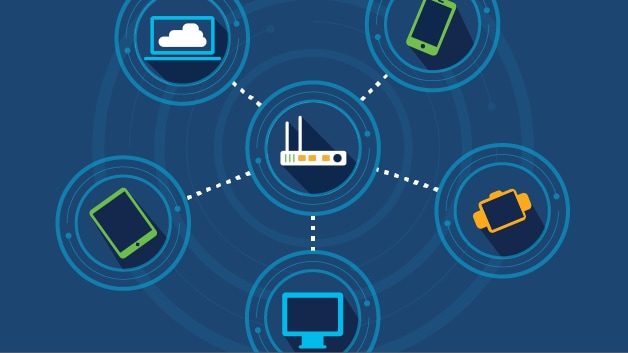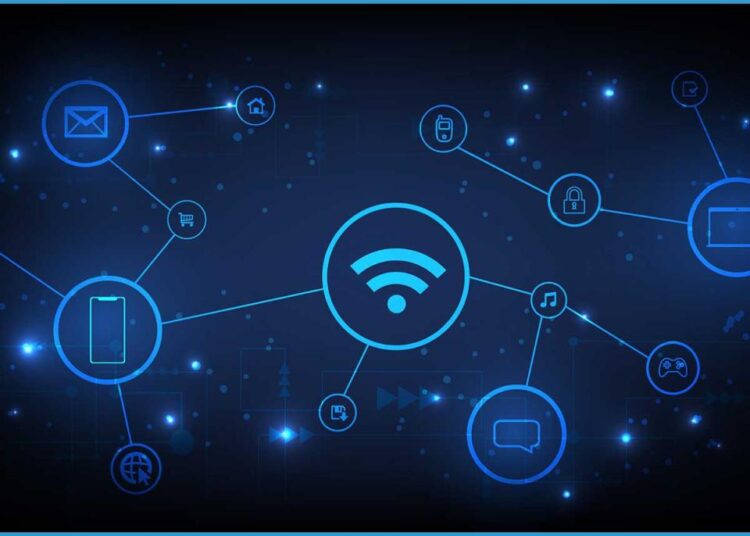Advanced Wireless Networks
![]()
At the core of this transformation are advanced wireless networking technologies, providing the invisible highways for data to travel at speeds and volumes previously unimaginable.
A. 5G and Beyond: The Hyper-Connected Future: 5G, the fifth generation of cellular technology, is far more than just faster internet. It’s a foundational shift, offering ultra-low latency, massive capacity for connected devices, and multi-gigabit speeds. These capabilities are critical for enabling real-time applications such as autonomous vehicles (where milliseconds matter for safety), sophisticated remote surgery, and immersive augmented and virtual reality experiences. Looking ahead, research into 6G and even terahertz communication promises even more dramatic leaps in speed (potentially terabits per second), reliability, and capabilities like holographic communication and pervasive sensing. This next generation of wireless will be the backbone for truly intelligent cities, advanced robotic systems, and instant global collaboration, fundamentally altering our relationship with digital information and physical space.
B. Wi-Fi 6E, Wi-Fi 7, and Beyond: Local Network Dominance: While cellular networks provide wide-area coverage, advanced Wi-Fi standards are revolutionizing local area connectivity. Wi-Fi 6E expands Wi-Fi into the 6 GHz band, offering significantly more bandwidth, lower congestion, and reduced latency for devices within a shorter range. Building on this, Wi-Fi 7 (802.11be, or “Extremely High Throughput”) promises even greater speeds, efficiency, and robustness by leveraging wider channels and more advanced modulation techniques. These advancements are crucial for supporting high-bandwidth applications like 8K video streaming, high-fidelity VR/AR, and seamless connectivity for dozens of smart home devices simultaneously. They are transforming homes and offices into truly high-performance wireless environments.
C. Low Earth Orbit (LEO) Satellite Internet: Projects like SpaceX’s Starlink, OneWeb, and Amazon’s Project Kuiper are deploying vast constellations of Low Earth Orbit (LEO) satellites to provide high-speed, low-latency internet access across the globe. This groundbreaking wireless technology is a game-changer for bridging the digital divide, offering reliable connectivity to remote and underserved areas previously cut off from high-speed internet. This “internet from space” democratizes access to information, enabling remote education, telemedicine, and digital commerce in regions that were previously isolated, creating a truly globally connected world that transcends terrestrial infrastructure limitations.
D. Wireless Mesh Networks: For robust and pervasive coverage within larger spaces, wireless mesh networks are becoming increasingly popular. Unlike traditional Wi-Fi setups with a single router, mesh systems use multiple interconnected nodes (or satellites) that communicate with each other to form a single, seamless network. This eliminates Wi-Fi dead zones, provides consistent signal strength, and automatically routes traffic efficiently. Mesh networks are ideal for smart homes with many connected devices, large offices, and even outdoor areas, ensuring reliable connectivity everywhere without complex wiring.
Smart Home and Building Automation
Wireless technologies are enabling unprecedented levels of control and automation within our living and working spaces, transforming static environments into responsive, intelligent ecosystems.
A. Smart Home Hubs and Voice Assistants: At the heart of most intelligent spaces are smart home hubs and voice assistants. Devices like Amazon Echo, Google Nest Hub, Apple HomePod, or Samsung SmartThings hubs act as central controllers, allowing users to manage an array of connected devices through voice commands, touch interfaces, or automated routines. They bridge different communication protocols (Wi-Fi, Bluetooth, Zigbee, Z-Wave, Thread), allowing devices from various manufacturers to seamlessly interact. These hubs are becoming increasingly intelligent, learning user preferences and proactively optimizing environmental settings for comfort, energy efficiency, and security.
B. Wireless Lighting and Climate Control: Smart lighting systems allow users to control brightness, color, and ambiance wirelessly via apps or voice, and integrate with schedules or motion sensors for automation. Beyond convenience, they contribute to significant energy savings by only illuminating spaces when occupied. Similarly, smart thermostats (like Nest or Ecobee) wirelessly learn occupancy patterns, integrate with local weather data, and optimize heating and cooling schedules, drastically reducing energy consumption and utility bills. These systems create dynamic indoor climates that are both comfortable and environmentally responsible.
C. Wireless Security and Surveillance Systems: Modern security has gone largely wireless. Wireless security camera systems offer high-definition video monitoring with features like motion detection, facial recognition, and cloud storage, providing real-time alerts and remote viewing from anywhere. Wireless video doorbells allow users to see and speak to visitors, even when away from home. Smart locks offer keyless entry via smartphone, fingerprint, or voice command, with remote locking/unlocking capabilities. These wireless security solutions provide unparalleled peace of mind and proactive protection for homes and businesses.
D. Automated Blinds, Shades, and Appliance Control: Wireless automated blinds and shades integrate with smart home systems, allowing users to control natural light, privacy, and insulation on a schedule or via remote command. This not only enhances comfort but also contributes to energy efficiency by managing solar heat gain. Smart plugs and power strips can transform any traditional appliance into a wirelessly controllable device, allowing for remote on/off, scheduling, and energy monitoring, making the entire home responsive to digital commands and optimizing power usage.
Wireless Energy Transfer

Perhaps one of the most futuristic applications of wireless technology is the ability to transfer energy without physical cables, promising a future of perpetual power for devices.
A. Inductive Charging for Devices: Inductive charging, based on electromagnetic induction, has become common for smartphones, smartwatches, and electric toothbrushes. By placing a device on a charging pad, power is transferred wirelessly over a short distance. This technology eliminates the need for numerous cables and ports, simplifying design and improving convenience. As the technology matures, it’s being integrated into furniture, vehicles, and public spaces, creating ubiquitous charging opportunities for portable electronics.
B. Resonant Wireless Power Transfer: While inductive charging requires close proximity, resonant wireless power transfer can transmit power over longer distances (several centimeters to meters) with greater efficiency. This technology utilizes magnetic resonance between two coils tuned to the same frequency. It’s being explored for charging multiple devices simultaneously, powering robots as they move across a factory floor, or even embedding into walls and floors to create “power pockets” where devices can charge automatically as they enter a room. This could revolutionize device design by making batteries smaller or even obsolete for certain applications.
C. Radio Frequency (RF) Energy Harvesting: RF energy harvesting captures ambient radio waves (from Wi-Fi routers, cellular signals, broadcast towers) and converts them into usable electrical energy. While the power harvested is currently small, it’s sufficient for ultra-low power devices like wireless sensors, IoT devices, and smart labels that require intermittent power and cannot rely on batteries. This technology enables truly self-sustaining wireless devices, eliminating the need for battery replacements and making large-scale sensor deployments more feasible in remote or hard-to-reach locations.
D. Laser-Based Wireless Power Transmission (Emerging): In its early stages of development, laser-based wireless power transmission involves converting electricity into a laser beam, directing it towards a receiver (photovoltaic cell), and converting it back into electricity. This method holds promise for long-distance power transfer, potentially powering drones in flight indefinitely, or even delivering power to remote industrial sensors. While safety considerations (e.g., eye safety) are paramount, this cutting-edge technology represents a truly transformative potential for remote energy delivery in the future.
Wearables and Bio-Integrated Wireless Devices
Wireless technologies are increasingly becoming integrated with our bodies, offering new ways to monitor health, enhance senses, and interact with the digital world.
A. Advanced Wireless Wearables for Health Monitoring: Modern wearable devices (smartwatches, fitness trackers, smart rings, continuous glucose monitors) leverage wireless connectivity to continuously track an array of health metrics: heart rate, blood oxygen, sleep patterns, skin temperature, and even ECGs. This data is transmitted wirelessly to smartphones or cloud platforms, providing real-time insights, early detection of anomalies, and personalized wellness recommendations. These devices are transforming preventative healthcare, chronic disease management, and personal fitness by providing continuous, non-invasive health data.
B. Wireless Brain-Computer Interfaces (BCIs): Wireless Brain-Computer Interfaces (BCIs) are at the forefront of human-computer interaction. Non-invasive wireless BCIs (e.g., EEG headsets) can detect brain signals to control devices with thought, improve focus, or monitor cognitive states. More advanced, implantable wireless BCIs aim to restore communication for paralyzed individuals or enable control of prosthetic limbs directly from neural impulses. These devices communicate wirelessly with external systems, opening up revolutionary possibilities for assistive technology and human augmentation, blurring the lines between mind and machine.
C. Wireless Augmented Hearing Devices: Modern hearing aids are sophisticated wireless devices, streaming audio directly from smartphones, TVs, and microphones. They often include advanced noise cancellation and directional sound processing, wirelessly adapting to different sound environments. Wireless cochlear implants directly stimulate the auditory nerve, providing a profound sense of hearing for individuals with severe to profound hearing loss. These devices leverage wireless communication to provide highly personalized and adaptive sound experiences, vastly improving the quality of life for millions.
D. Wireless Biosensors and Smart Implants: Beyond external wearables, wireless technologies are enabling the development of miniaturized biosensors and smart implants that reside within the body. These devices can wirelessly monitor internal physiological parameters, deliver medication on demand, or provide diagnostic information to external receivers. Examples include wirelessly transmitting glucose monitors for diabetics, smart stents that monitor blood flow, or nerve stimulators that can be controlled wirelessly for pain management. This pushes the frontier of personalized and proactive medicine by providing continuous, internal biological data.
Wireless in Logistics, Manufacturing, and Beyond
Wireless wonders are not confined to consumer applications; they are revolutionizing large-scale industrial operations, logistics, and resource management.
A. Wireless Industrial IoT (IIoT) for Smart Factories: The Industrial Internet of Things (IIoT) leverages wireless sensors and connectivity to create “smart factories.” Wireless sensors monitor machinery performance, predict maintenance needs (predictive maintenance), track assets, and optimize production lines in real-time. This reduces downtime, improves efficiency, and enhances safety. Wireless robotics and automated guided vehicles (AGVs) communicate seamlessly, streamlining material handling and assembly processes without the need for cumbersome cables, making factories more flexible and responsive.
B. Wireless Asset Tracking and Logistics: In logistics and supply chain management, wireless asset tracking solutions are transforming efficiency. GPS trackers, RFID tags, and Bluetooth Low Energy (BLE) beacons provide real-time location data for goods in transit, pallets in warehouses, or equipment on job sites. This enables precise inventory management, theft prevention, and optimization of delivery routes. Wireless sensor networks can also monitor environmental conditions (temperature, humidity) of sensitive cargo, ensuring product quality throughout the supply chain.
C. Wireless Smart Agriculture (Precision Farming): Smart agriculture utilizes wireless sensor networks and IoT devices to optimize crop yields and resource usage. Wireless soil sensors monitor moisture, nutrient levels, and pH, transmitting data to central systems. Drones equipped with wireless cameras and multispectral sensors provide aerial insights into crop health and irrigation needs. Wirelessly controlled precision irrigation systems can then deliver water exactly where and when needed, reducing waste and improving agricultural productivity, making farming more efficient and sustainable.
D. Wireless Vehicle-to-Everything (V2X) Communication: The future of transportation is deeply intertwined with Vehicle-to-Everything (V2X) communication. This wireless technology allows vehicles to communicate with each other (V2V), with infrastructure (V2I), with pedestrians (V2P), and with the network (V2N). This real-time data exchange enhances road safety by preventing collisions, optimizes traffic flow, and is crucial for the development of fully autonomous vehicles. It creates a dynamic, interconnected transportation ecosystem that is safer, more efficient, and less prone to congestion.
Challenges and Ethical Considerations
While wireless wonders promise immense progress, their widespread adoption also presents significant challenges and ethical considerations that demand careful and proactive management.
A. Cybersecurity and Data Privacy Risks: The pervasive nature of wireless connectivity creates a vast attack surface for cyber threats. Securing billions of interconnected devices from hacking, ensuring the privacy of transmitted data, and preventing unauthorized surveillance are monumental challenges. Robust encryption, secure authentication protocols, and continuous software updates are critical, but the sheer volume of devices makes this a persistent concern requiring constant vigilance and innovation in cybersecurity tools.
B. Spectrum Management and Congestion: Wireless communication relies on finite radio spectrum. As more devices come online and demand higher bandwidth, managing the electromagnetic spectrum to prevent interference and ensure efficient use becomes increasingly complex. Innovations in spectrum sharing, dynamic spectrum access, and the use of higher frequency bands (like millimeter wave and terahertz) are crucial to accommodate future wireless demands.
C. Digital Divide and Equitable Access: While LEO satellites are bridging gaps, the full benefits of advanced wireless wonders may not be equally distributed. There’s a risk of exacerbating the digital divide if access to high-speed, reliable wireless connectivity remains unequal, particularly in developing regions or rural areas. Ensuring universal access to these transformative technologies is vital for equitable economic development and social inclusion.
D. Health Concerns (EMF Exposure) and Public Perception: Public concern about potential health effects from electromagnetic field (EMF) exposure from wireless devices and infrastructure, particularly 5G, persists despite scientific consensus from major health organizations. Addressing these concerns with transparent research, clear communication, and adherence to safety guidelines is crucial for building public trust and ensuring responsible deployment of wireless technologies.
E. Regulation and Interoperability: The rapid evolution of diverse wireless technologies and standards can lead to fragmentation and interoperability challenges between different devices and ecosystems. Developing common standards (like Matter for smart homes) and implementing flexible regulatory frameworks that encourage innovation while ensuring safety and consumer protection are crucial for a cohesive and user-friendly wireless future.
Conclusion
In conclusion, the wireless wonders of our time are far more than just a convenience; they are a fundamental force transforming space in unprecedented ways. From the invisible currents powering our devices to the ubiquitous networks connecting every corner of the globe, these innovations are dismantling old limitations and creating a fluid, intelligent, and hyper-connected world. While the journey involves navigating complex challenges related to security, privacy, and equitable access, the immense potential for efficiency, personalization, and a truly interconnected future propelled by these wireless marvels is boundless. We are living in the dawn of a new wireless era, where the once-imaginable is rapidly becoming the everyday reality.











